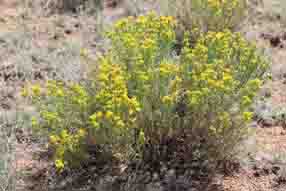Medicine:
"A cup of the finely chopped herb is steeped for thirty minutes in a quart of water, strained, and the tea added to a hot bath to alleviate the pain of arthritis and rheumatism. --- The tea may also be drunk for stomach ache, especially in the morning, and as a treatment for excessive menstruation. Although by no means a heroic medicine it is common, safe, and may sometimes work so well for joint inflammations as to supplant salicylate (aspirin) treatments." (Moore 74)
"For Pueblo Indians throughout New Mexico this is one of the most important medicinal plants, presenting and enormous variety of applications. Hispanics, too, have discovered many medicinal uses for snakeweed, some of then no doubt learned from the Publoans shortly after the Spaniards first marched up the Rio Grande.
A tea made from the entire plant except for the roots is still used by Cochiti men for an emetic; for the same purpose Cochiti women prefer a weaker brew steeped from juniper twigs. People for Acoma, Laguna, Santo Domingo, and Santa Ana pueblos have used snakeweed tea as a cleansing emetic, historically sometimes to purify the body before a hunt. At Jemez, San Juan, and San Ildefonso the tea or its vapors has been used by birthing mothers or on the newborn following childbirth and at Zuni to relieve urinary retention or to increase physical strength. Rheumatism, rattlesnake bites and eye problems have all been treated with such a tea at various Rio Grande pueblos.
Sweat baths concocted from steeped broom snakeweed are associated with curing colds and sore throats at Santa Clara and fever at Isleta, and a liquid concentration has been applied on sores, bruises, or aching muscles at Isleta, Acoma, and Zuni." (Dunmire and Tierney 145-6)
"Broomweed's effectiveness is said to rival that of aspirin for the relief of arthritis pain, for which the tops of the plant are boiled in water and the resulting teas is used both for drinking and for adding to bathwater." (Finley and Nieland 58)
"(Comanche) Compound containing leaves used for whooping cough. (Isleta) Poultice of moistened leaves used for bruises. Infusion of leaves used as a bath for fevers. Infusion of leaves used for venereal diseases. (Keres, Western) Strong, black infusion of plant used as a rub for rheumatism. Infusion of plant used as a cathartic. Plant used as an ingredient in the sweat bath. Infusion of plant used as an emetic. Infusion of plant used as an eyewash. Chewed leaf juice taken for and rubbed on rattlesnake bites. Infusion of leaves used as a wash for horses after castration. (Tewa) Plant used on hot coals to fumigate patient with painful menstruation." (Moerman 253)
Other Uses:
"Clearly, snakeweed is a plant associated with good feelings at some pueblos. At Sandia each year people take bundles of wild mixed with snakeweed branches to the home of their cacique, the chief of the pueblo, during the twelve days following the winter solstice to serve as a blessing and for nurture." (Dunmire and Tierney 147)
"(Navajo) Tops used to make a yellow dye. (Jemez) Plant chewed and juice spit upon bees to kill the insects. (Hopi) Sprig attached to the paho 'prayer emblem'. Sprigs tied on prayer sticks during the December ceremonies." (Moerman 254)
